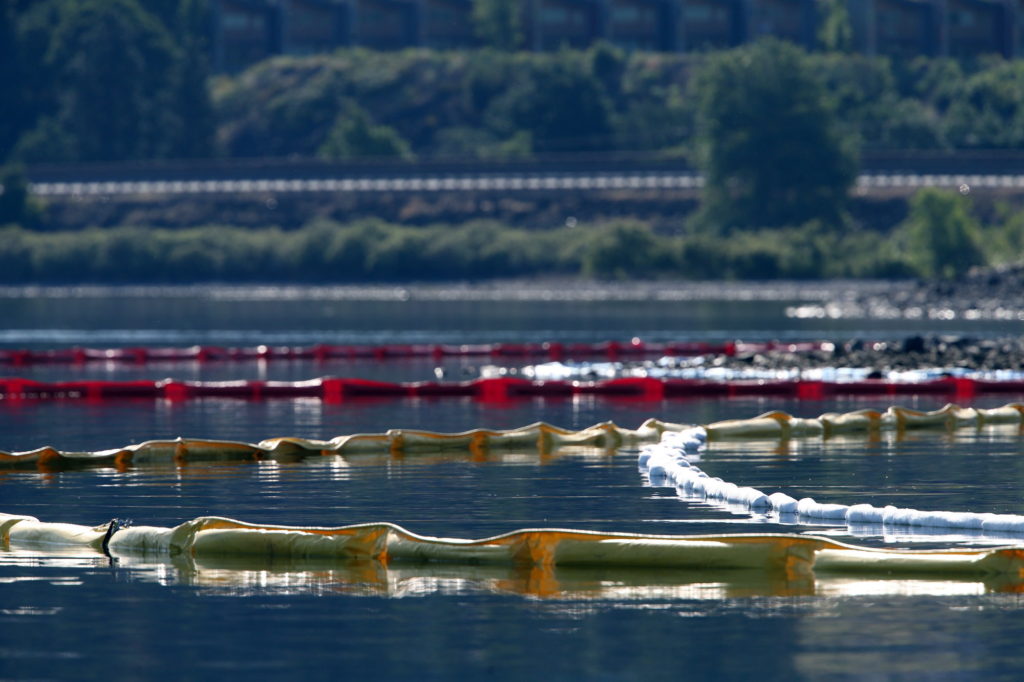PORTLAND — The fiery derailment of an oil train in Oregon’s Columbia River Gorge has state transportation officials asking for a halt to the massive trains because of concerns their heavier weight could be putting extra strain on a certain type of bolt that fastens the rails to the tracks.
The Oregon Department of Transportation discussed its concerns about the safety of the so-called “lag bolts” in a presentation Thursday to the Oregon Transportation Commission and made public a letter it mailed to the Federal Railroad Administration on June 8 asking for the moratorium.
Union Pacific, which operated the train, has said the June 3 derailment was caused by a failure of the bolts, fasteners which are used to attach the rail to the rail tie. The accident forced evacuations in the tiny town of Mosier, about 70 miles east of Portland, and spilled 42,000 gallons of oil into the Columbia River. No one was injured.
In a presentation to commission members, ODOT administrator Hal Gard said the lag bolts found at the scene were rusted on both ends, indicating they had been sheared off before the derailment. State officials showed a photo of a pile of lag bolts collected at the site.
Trains that carry only crude oil began running in that section of the Columbia River Gorge in 2014 and state investigators are concerned that the heavier weight and shorter length of those trains might be causing the lag bolts to break. The trains’ weight is spread out over a shorter distance, increasing the pressure on the tracks.
Without the fasteners anchoring the rails to the rail ties, the parallel rails can be pushed further apart by the train’s weight, causing a derailment, said Tom Fuller, ODOT’s director of communications. The sloshing of the liquid oil inside the tankers might also mean additional stress as the weight of the train’s contents shifts on curves, he added.
“The liquid is heavier and the weight is even more concentrated because there’s a shorter distance between the wheels and that’s what allowed one of the cars to literally come off the rails and then it pulled the other cars with it,” he said.
The lag bolt system was installed on the Columbia River Gorge route in 2001, Gard said, and the rails at the location were replaced in 2013.
Tests conducted by both Union Pacific and ODOT for flaws in the tracks didn’t turn up the faulty bolts, Fuller said.
“Our concern right now is if Union Pacific or ODOT weren’t able to determine that these bolts were broken, how do we know there aren’t more of these bolts broken in other places?” he said. “Where else are these bolts installed? Where else might this exist … just waiting to have a derailment?”
Matthew Lehner, a spokesman for the Federal Railroad Administration, said he would issue a press release Thursday but did not have an immediate comment.
Union Pacific said it has increased the frequency of inspections since the derailment.
The company is doing walking inspections each month on curved sections of track in the Columbia River Gorge and will use a special type of testing to detect problems once every three months instead of once every 18 months, said Justin Jacobs, Union Pacific spokesman. Oil trains are not currently running in the gorge, he said.
Jacobs could not provide more details about why the lag bolts failed, but cited a 99.9 percent safety record.
“Has a lug nut on a car tire ever failed? Yes, it has. Does it happen very often? No,” he said. “Safety is a priority for us.”
At least 27 oil trains and 11 ethanol trains have been involved in major fires, derailments or spills during the past decade in the U.S. and Canada, according to an Associated Press tally from data kept by transportation agencies and safety investigators from the two nations.
Hundreds more rail cars have released smaller amounts of crude following less-severe mishaps.
Combined, the accidents released more than 3.6 million gallons of crude and 2.3 million gallons of ethanol, according to safety investigators and an AP analysis of the data. Investigations into some of the accidents are ongoing and release volumes are incomplete.



